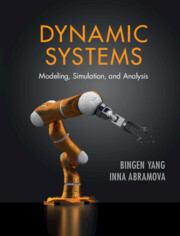Refine search
Actions for selected content:
1550 results in Control systems and optimization
Appendix B - Getting Started in Simulink and Simscape
-
- Book:
- Dynamic Systems and Control Engineering
- Published online:
- 04 August 2023
- Print publication:
- 15 June 2023, pp 889-913
-
- Chapter
- Export citation
7 - System Transfer Function Analysis
- from Part II - Analysis of Multi-Domain Dynamic Systems
-
- Book:
- Dynamic Systems and Control Engineering
- Published online:
- 04 August 2023
- Print publication:
- 15 June 2023, pp 312-374
-
- Chapter
- Export citation
14 - Advanced Topics in Control Engineering
- from Part IV - Analysis and Feedback Control of Modern Systems
-
- Book:
- Dynamic Systems and Control Engineering
- Published online:
- 04 August 2023
- Print publication:
- 15 June 2023, pp 829-886
-
- Chapter
- Export citation
8 - Analysis of Feedback Control Systems
- from Part III - Introduction to Feedback Systems
-
- Book:
- Dynamic Systems and Control Engineering
- Published online:
- 04 August 2023
- Print publication:
- 15 June 2023, pp 379-467
-
- Chapter
- Export citation

Dynamic Systems
- Modeling, Simulation, and Analysis
-
- Published online:
- 28 April 2023
- Print publication:
- 24 November 2022
-
- Textbook
- Export citation
6 - CRC Method for Identifying TITO Systems by CSOPTD Models
-
- Book:
- Identification and Classical Control of Linear Multivariable Systems
- Published online:
- 31 July 2022
- Print publication:
- 05 January 2023, pp 117-136
-
- Chapter
- Export citation
List of Abbreviations
-
- Book:
- Identification and Classical Control of Linear Multivariable Systems
- Published online:
- 31 July 2022
- Print publication:
- 05 January 2023, pp xxiii-xxiv
-
- Chapter
- Export citation
Acknowledgements
-
- Book:
- Identification and Classical Control of Linear Multivariable Systems
- Published online:
- 31 July 2022
- Print publication:
- 05 January 2023, pp xix-xxii
-
- Chapter
- Export citation
Preface
-
- Book:
- Identification and Classical Control of Linear Multivariable Systems
- Published online:
- 31 July 2022
- Print publication:
- 05 January 2023, pp xv-xviii
-
- Chapter
- Export citation
13 - Control of Stable Non-square MIMO Systems
-
- Book:
- Identification and Classical Control of Linear Multivariable Systems
- Published online:
- 31 July 2022
- Print publication:
- 05 January 2023, pp 265-300
-
- Chapter
- Export citation
2 - Identification and Control of SISO Systems
-
- Book:
- Identification and Classical Control of Linear Multivariable Systems
- Published online:
- 31 July 2022
- Print publication:
- 05 January 2023, pp 21-50
-
- Chapter
- Export citation
3 - Introduction to Linear Multivariable Systems
-
- Book:
- Identification and Classical Control of Linear Multivariable Systems
- Published online:
- 31 July 2022
- Print publication:
- 05 January 2023, pp 51-84
-
- Chapter
- Export citation
9 - Identification of Multivariable SOPTD Models by Optimization Method
-
- Book:
- Identification and Classical Control of Linear Multivariable Systems
- Published online:
- 31 July 2022
- Print publication:
- 05 January 2023, pp 177-204
-
- Chapter
- Export citation
Appendix C - For Chapter 7
-
- Book:
- Identification and Classical Control of Linear Multivariable Systems
- Published online:
- 31 July 2022
- Print publication:
- 05 January 2023, pp 357-370
-
- Chapter
- Export citation
Contents
-
- Book:
- Identification and Classical Control of Linear Multivariable Systems
- Published online:
- 31 July 2022
- Print publication:
- 05 January 2023, pp vii-xiv
-
- Chapter
- Export citation
8 - Identification of Centralized ControlledMultivariable Systems
-
- Book:
- Identification and Classical Control of Linear Multivariable Systems
- Published online:
- 31 July 2022
- Print publication:
- 05 January 2023, pp 157-176
-
- Chapter
- Export citation
15 - Trends in Control ofMultivariable Systems
-
- Book:
- Identification and Classical Control of Linear Multivariable Systems
- Published online:
- 31 July 2022
- Print publication:
- 05 January 2023, pp 319-338
-
- Chapter
- Export citation
Notations
-
- Book:
- Identification and Classical Control of Linear Multivariable Systems
- Published online:
- 31 July 2022
- Print publication:
- 05 January 2023, pp xxv-xxx
-
- Chapter
- Export citation
7 - Identification of StableMIMO System by Optimization Method
-
- Book:
- Identification and Classical Control of Linear Multivariable Systems
- Published online:
- 31 July 2022
- Print publication:
- 05 January 2023, pp 137-156
-
- Chapter
- Export citation
Appendix B - For Chapter 3
-
- Book:
- Identification and Classical Control of Linear Multivariable Systems
- Published online:
- 31 July 2022
- Print publication:
- 05 January 2023, pp 351-356
-
- Chapter
- Export citation
